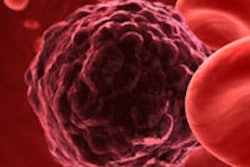
As the incidence of oral cancer cases increases, researchers are looking for ways to better treat the disease and also the debilitating side effects that survivors must deal with following surgery and radiation treatments.
Toward this end, clinical researcher Ron Karni, MD, and colleagues at the University of Texas Medical School at Houston have come up with a way to visualize how the lymphatic system is affected in head and neck cancer (HNC) patients by using near-infrared (NIR) fluorescence optical imaging and injectable fluorescent dyes. They are recruiting HNC patients for a clinical trial designed to demonstrate how this technology can help improve patients' lives following treatment.
 Ron Karni, MD.
Ron Karni, MD."In many cases, the cure we provide causes new disease," said Dr. Karni, an assistant professor in the department of otorhinolaryngology -- head and neck surgery, who specializes in transoral robotic surgery for the treatment of head and neck cancers.
One factor that hasn't been adequately addressed in HNC is survivorship, he said, adding that this is one of the first studies that deals specifically with issues of survivorship on a biologic level.
"You'll walk into the room two, three, or four years after a cancer patient has been treated and you'll say, 'Look, good news, sir. I see no evidence of cancer on your x-ray. Your exam looks great today so you're cured,' " Dr. Karni told DrBicuspid.com. "But the patients don't run out of the room skipping because they're left with so many side effects. They're so often debilitated and handicapped and maimed by the treatment, so this is a really important study."
While many of the issues are side effects of radiation therapy, others are tied into lymphatic edema -- a lymphatic obstruction.
"We don't have good metrics to determine when to even call it lymphedema, so part of the secondary objective of the study is to describe on an anatomical level lymphedema in the head and neck," Dr. Karni noted.
Trouble swallowing or neck swelling after treatment that many HNC patients experience after treatment is due to lymphedema, Dr. Karni said.
"We're using different vocabularies but we're actually talking about the same problem," he noted. "It's all lymphatic swelling; it's an obstruction."
'Profound lymphedema'
The lymphatic system in the head and neck is extremely well-organized and reliable in healthy people. But cancer often infiltrates the lymph nodes, causing lymphatic obstruction, Dr. Karni said.
Head and neck cancers frequently require surgery followed by radiation treatments, which completely disrupt the lymphatic system, he added. Surgery often involves removing lymph nodes and also the lymphatic highways between the lymph nodes, he noted.
"When we do a neck dissection, we're not just plucking cherries out of bowl," he explained. "We're actually removing the entire packet of lymphatics that travels along the jugular chain. We're basically taking what is an open, functioning highway system that carries immune molecules and other types of things and we're shutting it down, cutting it out, breaking it up, burning it up. And the side effects can be very deleterious."
Following treatment for their disease, about half of HNC patients suffer profound lymphedema, swelling due to blockage of the lymph vessels that drain fluid from tissues throughout the body and allow immune cells to travel where they are needed.
"First, the surgeon comes and takes out those lymph nodes and further interrupts the lymphatics, then radiation completely wipes out the lymphatics," Dr. Karni explained. "So it's one hit after another."
Breast cancer patients who have their lymph nodes removed from under their armpits and then have radiation often experience swollen arms, he said. Lymphedema specialists then wrap their hands to try to encourage the fluid to go back to the chest, which is where lymphatic fluid collects.
But with HNC patients, it's not possible to wrap their necks to try to push the fluid down, so massage techniques are used to try and move the fluid with the fingers, he noted.
Dr. Karni and his team are now recruiting patients for a clinical trial that involves using near-infrared fluorescence optical imaging and injectable fluorescent dyes to track movement in the lymphatic system. One of the benefits of the technique is that no radiation is involved, he pointed out.
"Using the camera and special goggles, you can literally see these molecules that are tagged with infrared light and watch them descend through the lymphatic system," he explained. "After surgery, we can watch the molecules move around the incision, around the area where the lymph was removed, and after radiation even more so."
 Researchers from the University of Texas Medical School at Houston are studying how the lymphatic system is affected in head and neck cancer patients by using an near-infrared fluorescence optical imaging system and injectable fluorescent dyes to track movement in the lymphatic system. Image courtesy of Dr. Ron Karni.
Researchers from the University of Texas Medical School at Houston are studying how the lymphatic system is affected in head and neck cancer patients by using an near-infrared fluorescence optical imaging system and injectable fluorescent dyes to track movement in the lymphatic system. Image courtesy of Dr. Ron Karni.Outpatient procedure
A key advantage of the technique is that it can easily be done in a doctor's office.
"The patient is just sitting there in my office and we inject this chemical into a variety of specific locations in the head and neck, and we sit there and watch this chemical drain through the lymphatics over the course of about an hour and we collect data," Dr. Karni explained. "We're essentially making maps of how the lymphatics are draining at all these different time points."
The researchers are currently recruiting patients, who will be imaged in Dr. Karni's office using the technology developed by his colleague Eva Sevick-Muraca, PhD, a professor of molecular medicine at the school, who is the study's principal investigator. A near-infrared fluorescence snapshot will be taken before the start of treatment, after surgery, after radiation therapy, and for a follow-up year.
The $600,000 study is being funded by the Cancer Prevention and Research Institute of Texas.
The technology will enable the researchers to produce anatomical "maps" that could help physicians with surveillance of head and neck cancers.
"These maps may in fact one day become a kind of x-ray," Dr. Karni said. "Physicians may rely on these maps to guide their therapy and that will make real life changes in people."



















